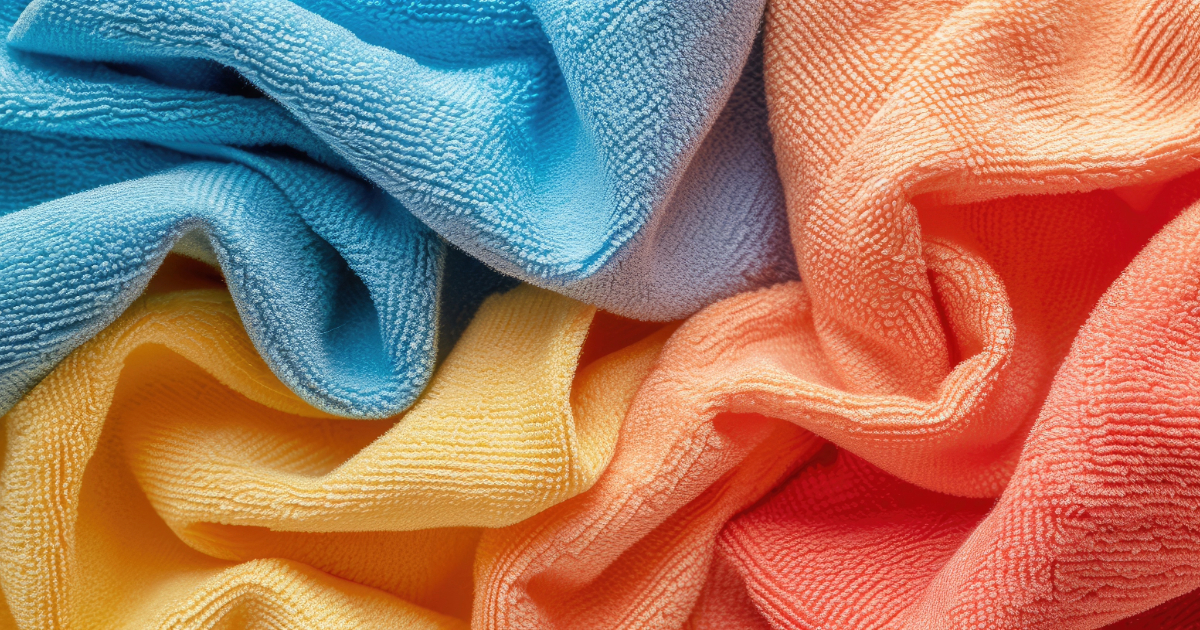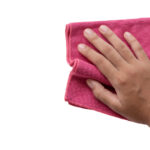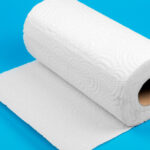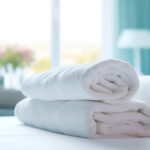Microfiber towels have become an essential cleaning tool for many households and businesses. Their ultra-fine fibers and constructions allow them to clean effectively while minimizing scratches and damage.

When shopping for microfiber towels, you may come across the term “GSM”. GSM stands for grams per square meter and refers to the density of the microfiber fabric. Understanding GSM can help you select the right microfiber towels for your intended uses.
How GSM Works
GSM measures the weight of fabric per square meter area. For example, a 350 GSM microfiber towel weighs 350 grams per square meter of fabric.
To calculate the GSM of a towel:
- Measure and calculate the towel’s total area in square meters
- Weigh the towel and note its mass in grams
- Divide the mass (grams) by the area (square meters) to get GSM
The higher the GSM, the more dense and heavy the microfiber fabric is. Towels with lower GSM will be thinner and lighter while towels with higher GSM will be thicker and heavier.
GSM Ranges for Microfiber Towels
Microfiber towels can range widely in GSM. Here are some common GSM levels and what they mean:
- 100-200 GSM – Very thin, lightweight towels best for delicate tasks like cleaning glasses or electronics. Too light for most detailing.
- 200-400 GSM – Lightweight towels good for interior detailing, buffing, and polish removal. Balance absorbency and scrubbing ability.
- 350-450 GSM – The most popular GSM for multi-purpose microfiber towels. Provides enough density for exterior detailing while remaining versatile.
- 500-600 GSM – Thicker, plusher towels designed for maximum absorbency. Best for drying and gentle exterior wiping.
- 600+ GSM – Extremely thick and plush towels only suitable for delicate drying and finishing work. Too thick for scrubbing or polishing.
How GSM Affects Towel Performance
The GSM level affects several factors that determine how a microfiber towel performs for auto detailing and cleaning:
Absorbency
Higher GSM microfiber can absorb and hold more liquid before becoming saturated. Thick, plush 500+ GSM towels excel at drying and buffing without leaving waterspots or streaks. Lower GSM towels have less absorbency for scrubbing dirt and cleaning without becoming oversaturated.
Pile Height
Pile refers to the length of the loops of microfiber on the surface. Higher GSM towels allow for a longer pile with more plushness. This provides a softer, gentler surface for wiping paint and clearcoat. Lower GSM has a shorter pile that allows more direct contact for removing polish and compound.
Durability
With more fabric per square meter, high GSM microfiber is generally more durable and resistant to ripping or fraying. Lower GSM towels are more delicate and prone to developing holes, especially if used for scrubbing or aggressive cleaning. Proper care extends the lifespan of all GSM levels.
Cleaning Ability
Thicker high GSM microfiber can clean gently with less pressure and friction. The plush piles cushion surfaces from abrasion. Lower GSM microfibers have less cushioning and directly contact surfaces for more aggressive scrubbing and cleaning. The tradeoff is potential for light surface marring if used improperly on paint or clearcoat.
GSM Recommendations by Detailing Task
Consider the GSM along with the weave and intended use when selecting microfiber towels for detailing. Here are common GSM ranges for different auto detailing jobs:
Interior Detail Towels (200-350 GSM)
For cleaning leather, plastic, vinyl, glass, and other interior surfaces, choose mid to lower GSM levels around 250-350 GSM. The shorter pile and thinner fabric allow sufficient scrubbing power to lift dirt from textured surfaces without overly abrasive friction.
Exterior Polishing Towels (300-400 GSM)
Polishing and paint correction requires the right balance of cleaning power and paint safety, achieved with microfiber in the 300-400 GSM range. The moderately short pile helps remove polish residue while minimizing pressure and swirls on the paint.
Exterior Buffing and Wax Removal Towels (350-450 GSM)
Popular multi-purpose buffing and wax removal towels are often 350-450 GSM. The medium thickness provides enough absorbency to lift off products without redepositing them back onto the paint. The moderate pile is soft enough for most clearcoats.
Drying Towels (500-700+ GSM)
After washing, highly plush and absorbent 500 GSM+ microfiber drying towels gently lift water off the vehicle without dragging or scratching. The thick piled fabric holds plenty of water in each pass. Softer 600-800 GSM towels may be preferred for delicate paints and coatings.
Glass Cleaning Towels (80-250 GSM)
Thin, low-pile 100-250 GSM microfiber towels are ideal for streak-free glass and smooth surface cleaning. The lighter fabric glides smoothly across windows without catching or dragging. Lower GSM leaves less lint and fiber residue behind.
Exceptions to GSM Rules
While GSM provides useful insight on microfiber density, it does not tell the full story. Consider these cases where GSM does not correlate with other towel properties:
- Waffle weave microfiber offers extreme absorbency in a low 300-400 GSM towel thanks to its textured waffle pattern.
- Suede microfiber lacks scrubbing ability due to the delicate suede fabric, even in higher GSM versions.
- Poly/microfiber blends with a polyester backing layer can have misleading high GSMs but reduced microfiber content.
- Multi-layered towels achieve high 600+ GSM by bonding two lower GSM towels together. This does not necessarily equal better quality or performance.
- Low quality manufacturing can create high GSM towels with inadequate construction, while high quality towels with dense microfiber can have moderate GSM.
So while GSM provides a useful starting point for evaluating towel density and absorbency, consider it along with the full context of the towel’s materials, construction quality, weave type, and intended uses.
Finding the Right GSM Towels for Your Needs
Here is a quick guide to selecting microfiber GSM for different detailing purposes:
- For buffing and drying paint, start with 450 GSM and go higher for extra plushness. 500-600 GSM is ideal for delicate paints.
- For removing polish and compounds, use 300-400 GSM with a blend of cleaning power and paint safety.
- For interior cleaning, choose 200-350 GSM towels with enough absorption without excessive pile.
- For windows and mirrors, 100-250 GSM microfiber leaves the least lint and streaks.
- For ultra plush drying and finishing, 600-800 GSM provides the softest touch.
- For general multi-purpose use, 350-450 GSM balances versatility, durability, and performance.
Test different GSM microfiber towels to discover your preferences for each detailing task. With experience, you will learn to match the right GSM towel with the intended use. Consider other factors like materials, weave, and quality along with the GSM rating when selecting microfiber products.
FAQs
Does higher GSM equal better quality?
Not necessarily. GSM only measures density. Quality depends on the microfiber material, construction, and manufacturing. A 300 GSM towel could outperform a 500 GSM towel from an inferior brand or poor quality.
Should I choose the highest GSM towel possible?
No, extremely high GSM towels may not be ideal for all purposes. Ultra-high 600+ GSM towels lack scrubbing power needed for removing polish and compound. Moderately high 450-500 GSM suits most detailing.
How is high GSM achieved in towels?
Manufacturers use dense microfiber material and tight weaves to create naturally high GSM towels around 500-600 GSM. Above 600 GSM, most towels bond two layers of lower GSM microfiber.
Do detailing towels need high 300+ GSM?
For buffing, drying, and paint correction, microfiber should be at least 300 GSM or higher for sufficient thickness, plushness, and absorbency. Interior and glass cleaning can use lighter 200-300 GSM towels.
Will higher GSM scratch my paint?
Not if used properly. The plush surface creates less friction and is less likely to swirl paint than terry cloth or paper towels. Use high GSM towels delicately without excessive pressure on paint.
Conclusion
Understanding GSM helps select microfiber towels with the ideal density, pile height, absorbency, and cleaning abilities.
While GSM does not guarantee quality on its own, it acts as a useful starting point for assessing towels.
Combine GSM knowledge with consideration of the materials, construction quality, and intended uses when choosing microfiber products.








